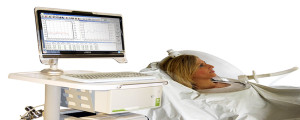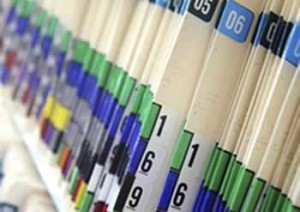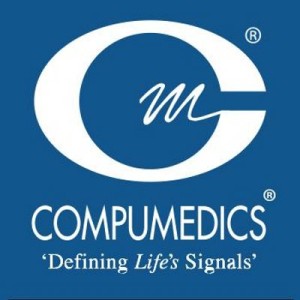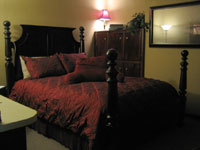Sleep testing can be an intimidating experience. Many patients who have undergone treatment recall their apprehension prior to their sleep study. Most of these patients would agree that the benefits of therapy far outweigh the inconvenience of evaluation.
Sleep Medicine Diagnosis & Treatment
Clinical Polysomnography
Sleep has been an ever-present topic of discussion in culture and society. We now read, hear and observe more knowledge and news about sleep than has ever been known in the history of mankind. Many of the sleep terms that today’s languages & cultures use, are derived from ancient Greek and Roman history. Greek mythology referred to the God of Sleep as Hypnos. Roman culture referred to him as Somnus – which is where the term polysomnography comes from. Sleep studies involve the acquisition of human bioparameters of numerous aspects into a collective recording or graph which can be further analyzed. Sleep medicine is essentially in it’s youth (or adolescence), compared to many other medical sub-specialties. However, technological advances have continued to permeate this field of medicine since its modern conception in the 50’s and 60’s. Sleep medicine societies largely revolve around 3 major sub-types – Research, Clinical Medicine and Industry.
Consultation
Prior to undergoing a sleep study, it is highly recommended that all patients be seen in consultation during a daytime office visit at SleepGR8 – The Institute of Sleep Medicine at Martin Clinic. The purpose of consultation is to obtain medical history and a better understanding of each patient’s complaints and symptoms. Furthermore, it helps to set up some expectations about what we need to be on the lookout for as any patient goes through the process. This discussion allows us to anticipate the best approach for effective evaluation during your sleep study.
How to know if sleep testing may be indicated or beneficial.
Sleep study requests may be initiated by you or your physician by calling SleepGR8 – The Institute of Sleep Medicine at Martin Clinic. We are easy to reach at 918-2-SLEEP-8. Our team will be glad to answer questions you may have and if they don’t have the answer, they’ll find someone who may be able to help you.

As with most cases in medicine, if you are already under the care of a physician or another provider – we definitely suggest that you discuss your concerns with them first. It is our pleasure not only to help each patient, but to also become a part of a cooperative effort to help individuals achieve improved levels of well-being and higher qualities of life.
Making certain that your healthcare provider is on board with your decision can generally help us to serve you better. If you don’t have a primary care or medical sub-specialist treating you, we will always accept self-referred patients.
This brings up one last thought on the issue, patients occasionally mention that they weren’t that they have an option to seek care from providers that may be outside of the general referral network of their own physician. In our case, this is usually due to the fact that we do not directly market our professional sleep services to physicians. Again, the old adage “out of sight, out of mind” ring a bell?
If you have a family member or personal acquaintance who has referred you to us – make certain that your provider is aware that state law requires ALL OKLAHOMA SLEEP CENTERS to be accredited. So, if everything is equal, you have word of mouth approval, and we are within your insurance network – we will be more than happy to work with your doctor to get you taken care of.
Specific Tests
Monitoring patients during sleep is a lot like putting a person’s entire body under a microscope. Many human bio-parameters are recorded and can be specifically divided into individual signals that can be arranged and re-arranged to develop a better understanding about the sleep of our patients.
Diagnostic Polysomnography
Diagnostic Polysomnography (PSG) is performed to document physiological events occurring during sleep. The test consists of a continuous recording, generally lasting from 6-8 hours and occurring during a patient’s typical sleep hours. The parameters that we monitor include limited electroencephalogram (EEG) (central & occipital), eye movement and muscle tone (EMG) for the purpose of staging sleep, respiratory effort by chest and abdominal movement, nasal and oral airflow, limb movements, limited electrocardiogram (ECG) and oxygen saturation by non-invasive pulse oximetry. The patient’s sleep behavior is also monitored using infrared lighting and a closed circuit camera. Additional parameters are included if ordered.
Continuous Positive Airway Pressure Titration
Continuous Positive Airway Pressure (CPAP) Titration is performed while the patient is breathing on CPAP in an effort to eliminate respiratory events occurring during the patient’s sleep. CPAP is initiated and is titrated upward until respiratory events, sleep arousals, and snoring are eliminated.
PSG with contingent CPAP Titration
PSG with CPAP therapy trial (Split Night) is a combination test incorporating both a diagnostic PSG and a CPAP titration over the course of one night. The apnea/hypopnea index (AHI) must meet or exceed insurance carrier requirements during the diagnostic portion of the study; which may vary by insurance carrier. The parameters monitored include those recorded in the diagnostic PSG with the addition of CPAP levels during the therapy trial. CPAP therapy may be initiated at lower AHI levels upon the physician’s request; however, in these cases caution must be taken to meet specific guidelines to justify CPAP rental coverage at home.
Multiple Sleep Latency Testing
Multiple Sleep Latency Testing (MSLT) is performed to provide objective documentation of daytime sleepiness and to definitively diagnose narcolepsy. This test is routinely performed following a diagnostic PSG to ensure there are no significant disruptions during the preceding night of sleep that contribute to sleepiness during the testing process. Urine drug screens are also performed to ensure sleepiness is not artificially induced. The testing includes limited EEG (central & occipital), eye movement, muscle tone for the purpose of staging sleep, and an ECG. The patient is recorded during 4 to 5 nap opportunities occurring every 2 hours lasting approximately 20-30 minutes following the PSG. Sleep behavior is also monitored using infrared lighting and a closed circuit camera.
Maintenance of Wakefulness Test (MWT)
Maintenance of Wakefulness Test is performed to document the patient’s ability to maintain wakefulness during 4 to 5 twenty-minute periods evenly spaced throughout the day in which he/she is monitored while sitting in a dark, quiet room without stimulation. The parameters monitored are the same as those for the MSLT. This test is often used to measure treatment effectiveness.
Sleep Studies - what to expect
A sleep study at SleepGR8 – The Institute of Sleep Medicine at Martin Clinic is a painless test that examines your quality of sleep and provides necessary information for your physician to accurately diagnose and treat your sleep disorder. To complete the test, you will spend one night in a private bedroom suite at the sleep lab.
Your personal suite features such comforts as a premium bed, high quality bedding and standard TV. An educational video on sleep apnea will be shown. During the night, measurements are recorded and data is collected that identify sleep stages, as well as brain and body system functioning.
We are pleased to use Compumedics Profusion software and hardware at SleepGR8 – The Institute of Sleep Medicine at Martin Clinic. This industry leading technology meets all technical standards as set-forth by the American Academy of Sleep Medicine.
The process explained...
We understand the distress our patients feel and we are committed to helping each patient find hope for an improved quality of life. A stay at our sleep lab is the first step in your journey back to restful sleep and healthier living.
We provide a home-like setting with cozy private rooms. Equipment is non-invasive and allows patients to sleep just as they would at home. Every detail of the process is designed to be comfortable and stress free. Many patients, in fact, report that they awaken feeling more rested than they have in a long time.
On the day of your sleep study, try to avoid caffeine after noon and try not to nap. Before arriving, wash and dry your hair, but do not apply any products. Pack an overnight bag as you would for an overnight hotel stay. You may wish to bring your own pillow and toiletries. If you have special needs, please advise us prior to your visit and, if possible, we will be happy to accommodate you.
During the night, measurements are recorded and data is collected that identify sleep stages, as well as brain and body system functioning. To measure brain waves, heart rate, airflow and eye movements, electrodes are placed on the head, chest, legs and under the chin. Bands are placed around the rib cage and abdomen to measure breathing movements, and a device is placed on your finger which measures blood oxygen levels.
All of these sensors are non-invasive and allow you to turn and move as you normally do while sleeping. Equipment and technicians remain in a separate room for your comfort and privacy. During the night, the sensors relay signals to a central control room where diagnostic equipment is located. After your night at the sleep center, board certified sleep specialists analyze the data collected. A detailed report is prepared that will help your physician diagnose and treat any identified sleep disorders.





Recent Comments